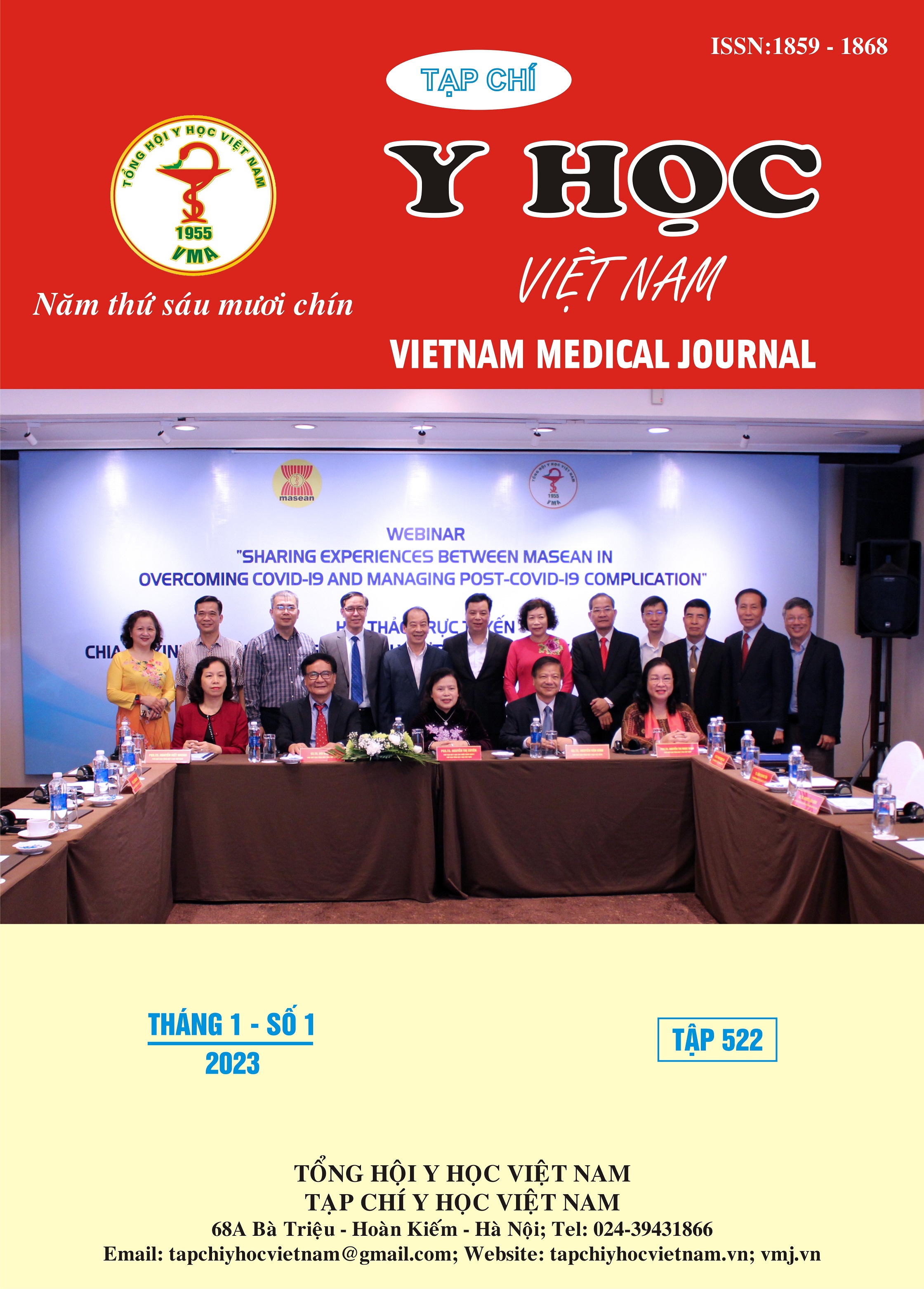ĐẶC ĐIỂM LÂM SÀNG, CHẨN ĐOÁN HÌNH ẢNH, VÀ MÔ BỆNH HỌC UNG THƯ HÀM MẶT ĐƯỢC CẮT BỎ TỔN THƯƠNG PHỨC HỢP MIỆNG-HÀM DƯỚI
Nội dung chính của bài viết
Tóm tắt
Mục tiêu: Mô tả đặc điểm lâm sàng và cận lâm sàng ở nhóm bệnh nhân được cắt bỏ tổn thương phức hợp miệng-hàm dưới do ung thư. Phương pháp nghiên cứu: Nghiên cứu được tiến hành trên 63 bệnh nhân được chẩn đoán là ung thư vùng hàm mặt được phẫu thuật cắt bỏ phức hợp xương hàm dưới tại Khoa Phẫu thuật Tạo hình Thẩm mỹ, Bệnh viện Răng hàm mặt Trung ương Hà Nội từ tháng 5/2014 đến tháng 7/2021. Kết quả: Tuổi trung bình của bệnh nhân là 54,05 ± 13,14 (thay đổi từ 19 đến 84), tỉ lệ nam/nữ = 2/1. Thời gian mắc bệnh trung bình là 4,44 ± 5,49 tháng (thay đổi từ 2 tuần đến 30 tháng). Các triệu chứng lâm sàng thường gặp là khối u (60,3%), sùi loét (69,8%), đau (65,1%), dễ chảy máu (33,3%), răng lung lay (22,2%), và hạch cổ (19,0%). Phần lớn tổn thương nằm ở vùng lợi hàm dưới (39,7%), sàn miệng (27,0%) và xương hàm dưới (17,5%). 96,8% bệnh nhân có tổn thương xương hàm dưới tương ứng với vị trí ung thư trên chẩn đoán hình ảnh. Kết quả mô bệnh học cho thấy hầu hết tổn thương là ung thư biểu mô tế bào vảy (81,0%). Phần lớn ung thư ở giai đoạn IV (74,6%). Kết luận: Các triệu chứng của ung thư vùng hàm mặt dễ bị nhầm lẫn với nhiều bệnh lành tính, do đó bệnh nhân cần được thăm khám kĩ lưỡng và chỉ định cận lâm sàng phù hợp để chẩn đoán bệnh sớm, giảm thiểu tổn thương các cấu trúc xung quanh do cắt khối u phát triển và xâm lấn.
Chi tiết bài viết
Từ khóa
clinical symptoms, pathological characteristics, composite oromandibular defect
Tài liệu tham khảo
2. P. Evans, P. Q. Montgomery, and P. J. Gullane, Principles and Practice of Head and Neck Surgery and Oncology, 2nd Edition. CRC Press, 2009.
3. B. P. Kumar, V. Venkatesh, K. A. J. Kumar, B. Y. Yadav, and S. R. Mohan, “Mandibular Reconstruction: Overview,” J. Maxillofac. Oral Surg., vol. 15, no. 4, pp. 425–441, Dec. 2016, doi: 10.1007/s12663-015-0766-5.
4. O. Camuzard et al., “Primary radical ablative surgery and fibula free-flap reconstruction for T4 oral cavity squamous cell carcinoma with mandibular invasion: oncologic and functional results and their predictive factors,” Eur Arch Otorhinolaryngol, vol. 274, no. 1, Art. no. 1, Jan. 2017, doi: 10.1007/s00405-016-4219-7.
5. Hàn Thị Vân Thanh, “Nghiên cứu điều trị ung thư biểu mô khoang miệng có sử dụng kỹ thuật tạo hình bằng vạt rãnh mũi má.” Luận án Tiến sĩ, Trường Đại học Y Hà Nội, 2013.
6. Nguyễn Anh Khôi, “Nghiên cứu tạo hình khuyết hổng sau phẫu thuật tạo hình ung thư hốc miệng bằng vạt da cân cẳng tay quay.” Luận án Tiến sĩ, Đại học Y Dược Thành phố Hồ Chí Minh, 2017.
7. J. M. López-Arcas et al., “The fibula osteomyocutaneous flap for mandible reconstruction: a 15-year experience,” J Oral Maxillofac Surg, vol. 68, no. 10, pp. 2377–2384, Oct. 2010, doi: 10.1016/j.joms.2009.09.027.
8. L. P. Rao, S. R. Das, A. Mathews, B. R. Naik, E. Chacko, and M. Pandey, “Mandibular invasion in oral squamous cell carcinoma: investigation by clinical examination and orthopantomogram,” Int J Oral Maxillofac Surg, vol. 33, no. 5, Art. no. 5, Jul. 2004, doi: 10.1016/j.ijom.2003.10.006.
9. T. A. Zrnc et al., “Complex Mandibular Reconstruction for Head and Neck Squamous Cell Carcinoma-The Ongoing Challenge in Reconstruction and Rehabilitation,” Cancers (Basel), vol. 12, no. 11, Art. no. 11, Oct. 2020, doi: 10.3390/cancers12113198.


